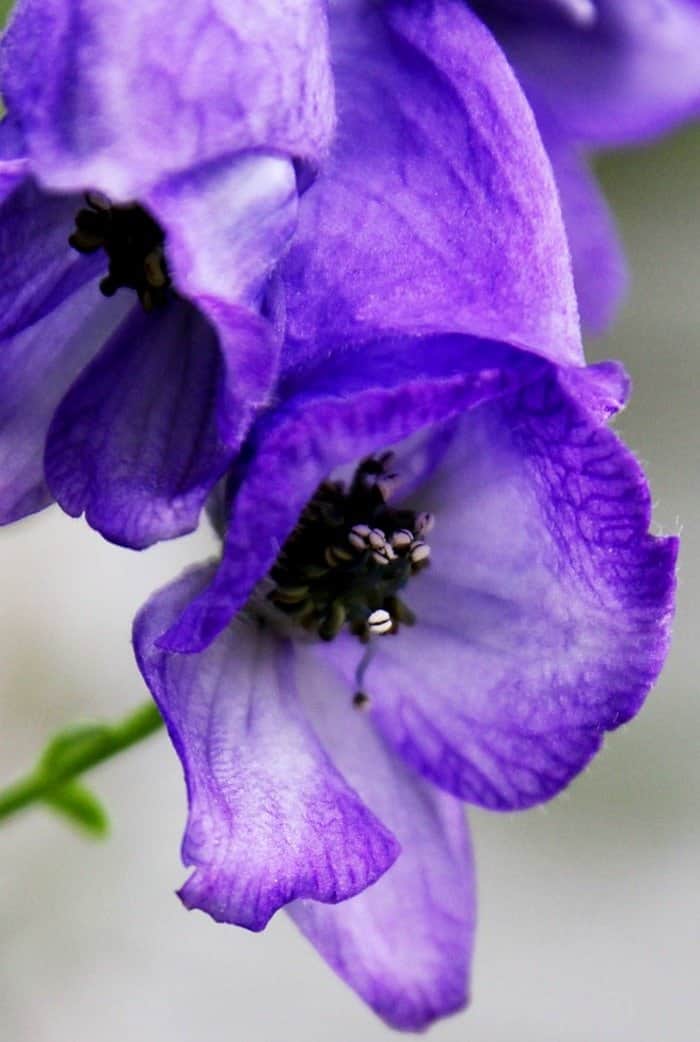
Despite several nights that touched on freezing temperatures in my Zone 6a garden, there has been no deeply killing frost. Even the most cold-resistant of the small solitary bees are now gone, but some perennials continue to flower. It’s a short list, but worth keeping in mind when plant shopping next spring. Any plant that is a late bloomer into the first weeks of November is definitely an asset. I have mostly single specimens of each, and plan to buy more to spread around, giving the appearance of a garden in bloom almost until the snow flies.
‘Arendsii’ monkshood (Aconitum carmichaelii (Arendsii group) ‘Arendsii’, 4 to 6 feet/120 to 180 cm, Zone 2) is the most bold and generous of these late-blooming perennials. It makes a tall stand of sturdy vertical stalks smothered with hood-type flowers on top. The satiny petals are deep royal purple and resistant to cool temperatures, giving them the appearance of fresh spring-like blooms. This plant is part of the attractive monkshood family (several of which bloom earlier in summer) that’s seriously toxic, and shouldn’t be cut for indoor bouquets. It’s quite safe to grow them in the garden, but leaves, flowers and stem sap must never be ingested. Wear gloves when cutting this plant down to be safe.
A clump of Japanese toad-lily (Tricyrtis hirta ‘Albomarginata’, 20 to 24 inches/50 to 60 cm, Zone 5) is blooming by the front steps; its arching branches hang over a small granite boulder. This is such an unusual plant, with a pleasing architectural form all summer and orchid-like white flowers with deep purple spots in autumn. It easily fits into gaps anywhere in part shade, and asks nothing from the gardener except to be admired. Several fancy hybrids are available, and it’s worthwhile to own several of these charmers. The one I’d like to find is T. formosana ‘Dark Beauty’ (28 to 32 inches/70 to 80 cm, Zone 5), a late blooming and slightly taller plant with purple-spotted mauve petals and a bright yellow eye.
Late-blooming ‘White Pearl’ bugbane (Actaea matsumurae ‘White Pearl’, 3 to 4 feet/90 to 120 cm, Zone 4) is putting on a bright show with tall, thin stems topped with fuzzy, white bottlebrush flowers and a sweet honey scent. These sway in the breeze and pair well with the tall flower spikes of ‘Karl Foerster’ feather reed grass (Calamagrostis x acutiflora ‘Karl Foerster’, 24 to 28 inches/60 to 70 cm, Zone 4).
What I like most about these late-blooming perennials is their fresh appearance. None looks pinched by the cold, the petals are all smooth and glowing with colour, and their posture is naturally graceful. Nothing looks battered or beaten down, there are no tattered edges or holes in foliage. These plants look like they are in their prime and feeling terrific!










I live in Zone 5a. My white-flowered hellebore has sizable flower buds on it, just ready to pop open. Is it likely to bloom again in the spring? My grasses are the stars of my garden in the fall, love them.
Hi Jean,
Hellebores have their flower buds all ready for spring, and it should be possible to see them now, low down in the crown of the plant. The flower buds are frost-proof and stay under the snow until early March.
However, there is one hellebore that blooms in November and December, Helleborus niger ‘Praecox’. I have several clumps in full bloom now. This plant is hard to find, but if your hellebore buds rise and open — then that’s the one you’ve got!
— Judith
I have a lovely purple allium that is still colourful…we have had frost to -6 and it is still happy. I do not know the cultivar………lost the tag years ago but have divided and spread it around and shared with family and friends. The colour is about the same as my purple flowering kale.
I know the Anemone is almost too typical to mention but those cheerful white flowers are glowing nicely into our shortened evenings.
Might I also suggest Dahlias? This is my first year growing a selection purchased at the Royal Botanical Gardens plant sale. I’m impressed; as a cut flower they are stunning and new blooms just keep opening (in November!)